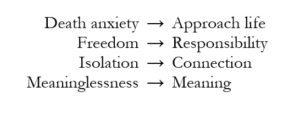
Prioritizing for Numbers People (of which I am not!)
Ok, I don’t make decisions like this. I’m much more of a Gendlin “felt sense” kind of chooser, or I’ll use my “Verb-ed To Do List” to decide based on what kind of energy I seem to have at the moment. But, sometimes I’m challenged in session to come up with experiments or homework that work for clients who are really different from me. This is a simple one that came up in session with a pair of engineers who were feeling overwhelmed because there was a lot on their “high stress to-do list” and they couldn’t seem to choose where to get started. (Yes, this is also sort about the emotion regulation piece of procrastination, but maybe that’s a post for another day.)
This was helped by the fact that they already had a (massive) to-do list ready. So, we take the to-do list, and we add three columns out to the side, with numbers 1-10:
- How EASY is this? (1 – desperately hard, 10 – super easy)
- How MUCH use will it be? (1 – not much use, 10 – incredibly useful)
- Sum.
That’s it. We didn’t’ quibble about what “easy” meant, though we chatted about how it might be effort, time, overcoming resistance, etc. We didn’t quibble about what “useful” meant, either, though we chatted about how it means something like pragmatic utility, stress reduction, etc. But they didn’t have trouble with either of those. So, they got started with the item that had the highest total sum and went from there.
Maybe it was even better that I’m not a numbers person, so I didn’t get drawn into complex formulae and overthinking the whole thing. And it was so simple, and the answer so clear, I think that helped them not tie themselves up in further knots about it.
And it’s not perfect, and if there were more resistance, I think it would need to be processed (e.g., if they tried to spend all session or all week arguing about the numbers in order to avoid doing anything). But not everything in therapy turns out to be a terrible struggle, actually! 🙂 And of course, they didn’t get through the whole list (partly because they realized some stuff on their list didn’t matter at all and partly because to-do lists are eternal). But that wasn’t the point. The point was giving them a way they could handle their decision fatigue/paralysis and get started. And they did.
Comment below: This seems to work pretty well for some of my Numbers/Engineering type clients, but I’d love to hear from you if you are one of those people… Or, how do you help clients with building the skills for prioritizing (or decision making, or problem solving, or…)

